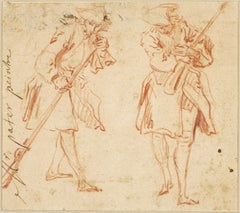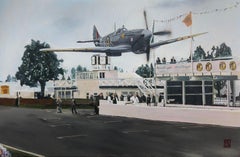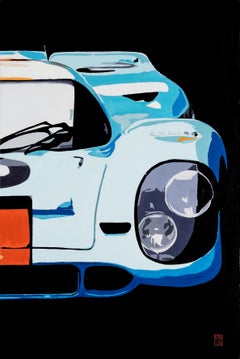Jean-Baptiste Pater Art
French, 1695-1736
Jean-Baptiste François Joseph Pater, born December 29, 1695 in Valenciennes and died July 25, 1736 in Paris, was a French Rococo painter.
Son of Antoine Joseph Pater, master sculptor, and Jeanne Élisabeth de Fontaine, he was first a pupil of his father who taught him sculpture. He abandoned sculpture in favor of painting to join, in 1706, a painter from the guild of Saint-Luc in Valenciennes, Jean-Baptiste Guidé. Around 1709-1711, Antoine Watteau, being back in Valenciennes, his father entrusted him to the master of whom he painted a portrait. Having moved to Paris, he worked with the latter, before Watteau's difficult character led them to separate in 1713.
He returns to Valenciennes, and tries to make a career there, but meets the opposition of the corporation of Saint-Luc of the city who wants to prevent him because he is not one of its members. He therefore returned to the capital when, in 1720, seized with remorse at the very end of his life, Watteau asked him to be with him, during the last month he had left to live, in order to give him his last advice. He will later say that he learned more during these three weeks of life together than during his years of apprenticeship. He therefore based his career on the imitation of the country festivals of the master with whom he had reconciled and even completed certain commissions after his death.
Accredited to the Academy on July 7, 1725 on a portrait by Hallé, he was received on December 31, 1728, with A country party. Rejoicing of soldiers as a piece of reception, “in the particular talent of gallant parties. Like Lancret, he drew his subjects, for his scenes at fairs, from military life or Italian comedy, from theater and fables.
His most prestigious clients were Frederick the Great, who posed for two portraits of "turqueries": The Sultan in the Harem and The Sultan in the Garden and owned more than forty paintings by him, and the Duke of La Force.
In delicate health, ill, he wrote his will on June 28, 1736, in favor of his sister Marie-Marguerite Pater. He died in his apartment on rue Quincampoix in Paris. His funeral took place in the church of Saint-Nicolas-des-Champs, and he was probably buried in the cemetery of the Innocents.to
1
Overall Width
to
Overall Height
to
1
1
1
1
1
1
1
1
1
10,026
2,754
1,379
1,375
1
1
Artist: Jean-Baptiste Pater
Two military studies, a preparatory red chalk drawing by Jean-Baptiste Pater
By Jean-Baptiste Pater
Located in PARIS, FR
As Florence Ingersoll-Smouse wrote in 1921 in her book devoted to Jean-Baptiste Pater, "a painter of the Fête galante, Pater is interesting both by his intimacy with Watteau, to whom many of his works are still attributed, and by his own value as an artist.” This sanguine, full of life and spontaneity, is typical of the preparatory studies made by the painter to be used later in the composition of his paintings.
1. Jean-Baptiste Pater, pupil and disciple of Antoine Watteau
Antoine Pater, Jean-Baptiste's father, belonged to the petty bourgeoisie of Valenciennes where he worked as a merchant-sculptor. His brother Jacques was a local painter who was probably involved in his nephew's training. Born on December 29, 1695, Jean-Baptiste Pater was first trained with Jean-Baptiste Guider, a local painter whose death in 1711 was probably the reason for Jean-Baptiste’s departure alongside Watteau, who was visiting Valenciennes. Watteau's difficult character led to their separation in 1713.
Back in Valenciennes, Jean-Baptiste Pater encountered difficulties with the powerful Corporation of Saint-Luke (to which he refused to belong) which forced him to return to Paris in 1718. He reconciled with Watteau shortly before his death (on July 18th 1721), inherited the commissions that Watteau had been unable to fulfil and completed some of his paintings.
Pater was accepted by the Académie Royale in 1725 but did not produce his reception painting The soldier’s revels until three years later. Throughout his brief career (he died at the age of forty on July 25th 1736), he mainly had a clientele of amateurs and received only one royal commission, shortly before his death.
2. Description of the drawing and related artworks
Pater had adopted his master Watteau's method of composition. His study drawings were carefully glued in a notebook and were used to animate his compositions.
His paintings sometimes suffer from a somewhat artificial composition, since the figures seem to be pasted one next to the other. This point has also been made about Watteau’s.
The theme of military scenes (which was at the time included in the genre of Fêtes galantes!) was one of Pater’s favourite subjects. Together with the Bathing Women...
Category
1720s Old Masters Jean-Baptiste Pater Art
Materials
Chalk
Related Items
Ray Hanna Spitfire, Goodwood 1998
Located in London, GB
After reading many pilots accounts of their experiences during WW2 I wanted to paint a tribute to their braveness. Fittingly at the 20th anniversary of the Goodwood Revival meeting i...
Category
2010s Jean-Baptiste Pater Art
Materials
Pigment
Gulf Porsche 917
Located in London, GB
This piece of car art was painted to celebrate the iconic Porsche 917-2 that dominated at Le Mans for many years by emerging artist Martin Allen.
The ori...
Category
2010s Jean-Baptiste Pater Art
Materials
Pigment
Dario Campanile’s Your Move (1999) symbolic painting that explores humanity
By Dario Campanile
Located in Hollister, CA
Dario Campanile’s Your Move (1999) is a layered and symbolic painting that explores humanity’s critical role in environmental preservation and extinction. At its center is a child—re...
Category
1990s Surrealist Jean-Baptiste Pater Art
Materials
Giclée
$3,600 Sale Price
20% Off
H 40 in W 30 in
La Re'ception
By Auguste Chabaud
Located in Belgrade, MT
Auguste Chabaud was born in Nimes, France and attended the Ecole des Beaux-Arts in Avignon and Paris.He lived in the area of Montmarte where he had a studio and painted various scene...
Category
Early 20th Century Cubist Jean-Baptiste Pater Art
Materials
Oil, Lithograph
Mix Tape number 1
Located in London, GB
Immerse yourself in a symphony of sight and sound with Martin Allen's "Mix Tape Number 1." Inspired by the nostalgia of mix cassette tapes, this vibrant masterpiece transcends tradit...
Category
2010s Pop Art Jean-Baptiste Pater Art
Materials
Pigment
The Non-Golden Calf (Das Nicht-Goldene Kalb)
By Arik Brauer
Located in Santa Monica, CA
Color etching
Category
1970s Other Art Style Jean-Baptiste Pater Art
Materials
Etching
$600 Sale Price
25% Off
H 17.875 in W 5.875 in
Mix Tape number 2
Located in London, GB
Immerse yourself in a symphony of sight and sound with Martin Allen's "Mix Tape Number 2." Inspired by the nostalgia of mix cassette tapes, this vibrant masterpiece transcends tradit...
Category
2010s Pop Art Jean-Baptiste Pater Art
Materials
Pigment
Reut Harel: Choose Happy - Giclee print on canvas. 39.3/27.5”
Located in Tel Aviv, IL
Reut Harel is a Pop Art artist who works in Tel Aviv and creates colorful, optimistic, vibrant art that combines detailed elements and emotions. Her works are characterized by a tend...
Category
2010s Pop Art Jean-Baptiste Pater Art
Materials
Giclée
$1,500
H 39.38 in W 27.56 in
untitled woman in boudoir original lithograph
By Louis Berthomme Saint-Andre
Located in Belgrade, MT
This lithograph is part of my private collection and in very good condition. It is original, numbered and signed by the artist in the plate and on the print. Guilde de la Gravure.
Category
Mid-20th Century Post-Impressionist Jean-Baptiste Pater Art
Materials
Oil, Lithograph
$396 Sale Price
20% Off
H 18 in W 12 in
Rare serigraph "After the Wedding"
By Giancarlo Impiglia
Located in Bridgehampton, NY
A rare serigraph by world-renowned Giancarlo Impiglia. This is an opportunity not to be missed.
Born in Rome, Impiglia moved to New York in the 70s, where he established a signatur...
Category
2010s Jean-Baptiste Pater Art
Materials
Screen
Dario Campanile, "Oggetti Semplici". Stunning still life featuring pink orchids
By Dario Campanile
Located in Hollister, CA
"Oggetti Semplici" is a flawless limited edition giclée, on high quality canvas, ready for stretching and framing. Edition 39/75
Dario Campanile is an Italian-born artist whose car...
Category
1990s Photorealist Jean-Baptiste Pater Art
Materials
Giclée
Dario CampanileDario Campanile, "Oggetti Semplici". Stunning still life featuring pink orchids, 2000
$3,600 Sale Price
20% Off
H 36 in W 30 in
Converse Marilyn Sneakers Art by Martin Allen – Iconic Pop Culture Meets Vintage
Located in London, GB
Step into a world where iconic pop culture and timeless artistry converge with the “Converse Marilyn Sneakers Art” – a captivating masterpiece from the renowned artist Martin Allen. ...
Category
2010s Pop Art Jean-Baptiste Pater Art
Materials
Pigment
$245
H 23.23 in W 16.54 in
Jean-baptiste Pater art for sale on 1stDibs.
Find a wide variety of authentic Jean-Baptiste Pater art available for sale on 1stDibs. You can also browse by medium to find art by Jean-Baptiste Pater in chalk and more. Much of the original work by this artist or collective was created during the 18th century and is mostly associated with the Old Masters style. Not every interior allows for large Jean-Baptiste Pater art, so small editions measuring 7 inches across are available. Customers who are interested in this artist might also find the work of Carle Vernet (Antoine Charles Horace Vernet), Bernard Picart, and Jacques Callot. Jean-Baptiste Pater art prices can differ depending upon medium, time period and other attributes. On 1stDibs, the price for these items starts at $13,200 and tops out at $13,200, while the average work can sell for $13,200.


